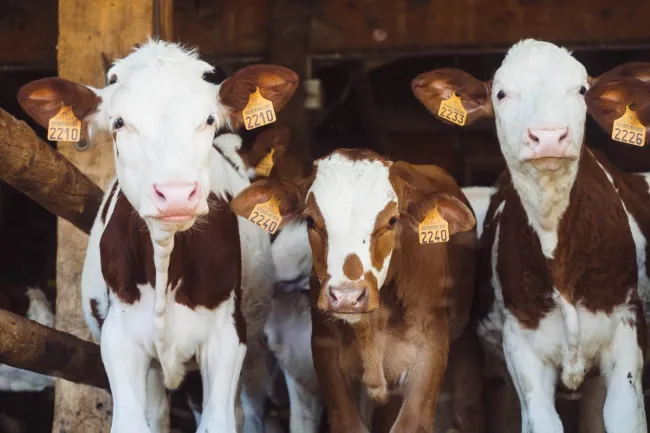This life cycle assessment of beef cattle production in the United States calculates greenhouse gas emissions, fossil energy use, blue water consumption and reactive nitrogen loss per kg of carcass weight.

Different production systems were modelled based on surveys and visits to farms, ranches and feedlots across different regions of the United States.
The figure below shows the main contributions to each impact category, based on the national average. For example, 56% of the carbon footprint is due to methane from enteric fermentation.
 Image: Figure 3, Rotz et al. Distribution of each environmental footprint among sources.
Image: Figure 3, Rotz et al. Distribution of each environmental footprint among sources.
The study uses newer values for global warming potential (GWP) than many other studies. Here is what the authors say regarding GWP values:
“Compared to most previous studies, an important change was made in calculating GHG emissions. The global warming potential (GWP) values for CH4 and N2O were updated to the latest 100-year values recommended by the Intergovernmental Panel on Climate Change (IPCC; Myhre et al., 2013). The GWP for CH4 was increased to 28, and this value considered the removal of carbon dioxide (CO2) from the atmosphere to create CH4. The GWP for N2O was decreased to 265. The net effect was about a 9% increase in our calculated carbon dioxide equivalent (CO2e) for beef cattle production compared to our previous studies.”
Regarding carbon sequestration, the authors made the following comments:
“A benefit often discussed in cattle production is that of C sequestration. On individual operations where appropriate transitions in management are made, soil organic matter can be accumulated for a period and C can be sequestered (Franzluebbers, 2005; Franzluebbers and Follett, 2005). This impact of beef cattle is likely small on a national scale. Most cattle producing operations in the U.S. have used relatively consistent management practices for many years, so soil C levels should be near a long-term equilibrium. Where opportunities exist for reducing the use of tillage in crop production or improving rotational grazing strategies, additional C can be sequestered and stored in the soil providing a short-term reduction in net greenhouse gas emissions (Franzluebbers, 2005; Rotz et al., 2009). These may provide other benefits by reducing fossil energy use and improving nutrient use efficiencies.”
For further discussion of carbon sequestration in grazing systems, see the FCRN’s report Grazed and Confused? (watch the video summary here).
Abstract
The environmental impacts of beef cattle production and their effects on the overall sustainability of beef have become a national and international concern. Our objective was to quantify important environmental impacts of beef cattle production in the United States. Surveys and visits of farms, ranches and feedlots were conducted throughout seven regions (Northeast, Southeast, Midwest, Northern Plains, Southern Plains, Northwest and Southwest) to determine common practices and characteristics of cattle production. These data along with other information sources were used to create about 150 representative production systems throughout the country, which were simulated with the Integrated Farm System Model using local soil and climate data. The simulations quantified the performance and environmental impacts of beef cattle production systems for each region. A farm-gate life cycle assessment was used to quantify resource use and emissions for all production systems including traditional beef breeds and cull animals from the dairy industry. Regional and national totals were determined as the sum of the production system outputs multiplied by the number of cattle represented by each simulated system. The average annual greenhouse gas and reactive N emissions associated with beef cattle production over the past five years were determined to be 243 ± 26 Tg carbon dioxide equivalents (CO2e) and 1760 ± 136 Gg N, respectively. Total fossil energy use was found to be 569 ± 53 PJ and blue water consumption was 23.2 ± 3.5 TL. Environmental intensities expressed per kg of carcass weight produced were 21.3 ± 2.3 kg CO2e, 155 ± 12 g N, 50.0 ± 4.7 MJ, and 2034 ± 309 L, respectively. These farm-gate values are being combined with post farm-gate sources of packing, processing, distribution, retail, consumption and waste handling to produce a full life cycle assessment of U.S. beef. This study is the most detailed, yet comprehensive, study conducted to date to provide baseline measures for the sustainability of U.S. beef.
Reference
Rotz, C.A., Asem-Hiablie, S., Place, S. and Thoma, G., 2019. Environmental footprints of beef cattle production in the United States. Agricultural Systems, 169, pp.1-13.
Read the full paper here. See also the Foodsource chapter Focus: the difficult livestock issue and the FCRN report Grazed and Confused?




Comments (0)